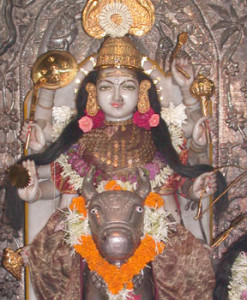No products in the cart.
Mumbadevi Temple in Mumbai is the temple of Maa Mumbadevi. Mumbai has derived its name from Goddess Mumbadevi. It is built to pay a tribute to the Goddess of Mumbai. There is a great mythological story attached to the creation of this temple.
The Mumbadevi Temple is situated at Bhuleshwar in Mumbai. Earlier the temple of Mumbadevi stood on the present day Victoria Terminus, which is situated in the central island of Mumbai. The current name of the city is derived from the resident deity of Mumbai, Goddess Mumbadevi. The temple itself may not impress much as there are not much architectural value added to it. Still it is an significant landmark as it is dedicated to MumbaDevi, the patron Goddess of the great city of Mumbai. Bombay has got its local name, Mumbai from this deity.
The benevolent Goddess Mumba, is dressed in silver robes and is ornamented with nose studs. She is the presiding deity of Mumbai. Mumba is a goddess who has no mouth and her face is orange colored. This may be a significant representation of the Mother Earth. She is worshiped with great devotion by the fisher folk called Koli.
In the Mumbadevi Temple, apart from the image of the Goddess MumbaDevi there also resides idols of Ganesh Indra, and Hanuman. It is believed that the Maa Mumba does not let down any of her devotees if they are sincere while offering their prayers.
Mumbadevi Temple, Maharashtra;
This temple was built in honour of the Goddess Amba. The Mumbadevi temple is six centuries old. The first Mumbadevi temple was situated at Bori Bunder, and is believed to have been destroyed between 1739 and 1770. After the destruction a new temple was erected at the same place at Bhuleshwar. The Goddess personifies Mother Earth and is still worshipped by the Hindu population of the northern Indo-Gangetic plain and southern India alike. The original temple built at the site where the Victoria Terminus station earlier was by Koli fishermen was demolished around 1737 and a new temple was erected in its place at Phansi Talao. The modern shrine contains an image of the Goddess Mumbadevi dressed in a robe with a silver crown, a nose stud and a golden necklace. To the left is a stone figure of Annapurna seated on a peacock. In front of the shrine is a tiger, the carrier of the Goddess.
The present name of the city is derived from the Goddess Mumbadevi. The temple itself is not impressive but is an important landmark as it is dedicated to MumbaDevi, the city’s patron deity.
The structure of Mumba Devi Temple is a marvelous sight for anyone who visits this shrine. The highlight of the Mumba Devi Temple is the idol of Goddess Mumbadevi, adorned with a silver crown, a golden necklace and a nose stud. The idol is placed on an altar, bedecked with marigold flowers. To symbolize Mother Earth, the idol of Mumbadevi has no mouth. Idols of ‘Hanuman’ and ‘Ganesh’ are also placed within the temple complex. Other figures include a stone idol of ‘Annapurna’ seated on a peacock and a sculpture of a fierce tiger.
By Road: The temple present in Mumbai. We can reach the Temple easily by hiring auto, bus or taxi from anywhere in the Maharashtra or from neighboring state. Maharashtra is connected with most of the Indian cities by road. The Maharashtra State Transport Corporation (MSTC) runs regulars bus service in the city.
By Rail: The nearest Railway Station to the temple is Mumbai central railway station
By Air: The Temple can be reached through nearest Mumbai Airport which is well connected with regular domestic flights to Delhi, Mumbai.
This temple Opening & Closing time is 6:00 AM – 9:00 PM.On Mondays the temple remaines closed. Outside the temple of Devi Mumba, there are stalls, which sell flowers, garlands and other things needed for offering ‘puja’. Jasmine, pink lotuses and orange marigolds are some offerings, which is considered auspicious and lucky by her devotees.
Navarathri is the most important festival of the temple. On the first day, they light a lamp made of clay. They spread rice and Nava Dhanyas – nine varieties of corns -. They fill a bronze pot with water and put five betel leaves, arecanut, a copper sheet and a dry date. This is called God Sthapana, which in South we call Aavahana – personifying the deity in a form. This is something like the Gada Sthapana with some variation in our consecration ceremonies. The water is spilled on the earth very carefully. The corns generate within 36 hours. On the first night of the Navarathri, Maratha artists play a drum called Savadha with music. On the seventh day, they dig a square pit, arrange bricks in an aesthetic manner. They put the coconuts brought by the devotees, burn them in small fire fuelled with butter. The ash of the burning is made into a paste. Devotees apply it on their eye brows. On the Dasara day (10th day), the corns grown 6 inches tall are plucked off and offered to the deity. Selected men and women get this plant. Women wear it on the hair while men have them on their turbans.



